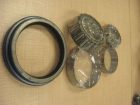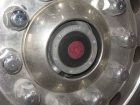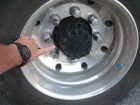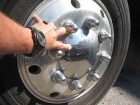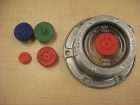
Equipment
Truck Tech: November 2015
Firefighters are a mechanic’s first line of preventative maintenance in the field. Firefighters driving each day have the responsibility to not only get on scene safely and do what they were trained to do, but to also keep a constant vigil on the rig. Report anything that does not feel, look, smell or sound right. If you are unsure about something, ask other firefighters for their opinions.
November 11, 2015
By Chris Dennis
 there is a certain part of that rig that goes unnoticed during regular maintenance: the wheel-end bearings. Take time to find (and check) your bearings.
there is a certain part of that rig that goes unnoticed during regular maintenance: the wheel-end bearings. Take time to find (and check) your bearings.There is a certain part of that rig that goes unnoticed during regular maintenance: the wheel-end bearings.
Photo 1 is an example of a tapered bearing assembly and wheel seal. They are mounted and then rotate on a spindle or axis. Front and rear axles as well as tag and pusher axles all have some kind of bearing that rotates around a fixed axis. Tag and pusher axles are additional axles in front of or behind the set of drive axles, depending on the truck design.
Fire departments across Canada, whether they have a dedicated apparatus-repair division or not, at times neglect to check wheel-end bearings (wheel bearings); usually it is because they rarely fail. But, as with wheels falling off vehicles many years ago, maintenance programs and inspection guidelines change to correct problems.
We now know that tires can fall off due to incorrect tightening sequences, incorrect torques or a lack of retorques (this should be done after a wheel was removed and/or replaced and the vehicle has gone 100 kilometres). So take a few minutes now and make a note to have wheel-bearing inspection added to your maintenance-inspection sheet. A note can also be added to the firefighter truck check sheet. Let me explain.
Wheel bearings on most class-8 rigs have wet wheel-end bearings. This means the style of bearing is lubricated and kept cool continuously while swimming in oil. In years gone by, and in some cases still today, some manufacturers packed wheel bearings with grease. Check with the original equipment manufacturer (OEM) to see if the wheel bearings are wet or packed.
Unlike wheel nuts, it is difficult to detect early wheel-bearing failure. You can put your hands and fingers on a wheel nut and feel it is loose. Wheel-nut indicators mounted on the nut are an easy way to determine if there is damage or if it is coming loose. We even have low tire-pressure monitors built into the rim and tire assembly, and on the end of the tire valve stem. Knowing when a wheel bearing is damaged is not so easy.
Let’s get our bearings.
Unlike a wheel nut, you can’t see a bearing. Photo 2 shows a steer axle end bearing hubcap, also known as a hub oiler or wheel-end cap. Photo 3 is of a drive axle. Behind the round cap with all the small bolts is the axle end or drive axle (not the drive shaft). Inside the drive axle is the wheel-end bearing. In photo 4, a chrome cover over the wheel assembly needs to be removed to expose the hub oiler cap.
There are a number of ways to check if the bearing is in OK shape. The first method can be done at the fire station by a firefighter. The easiest bearing to check is the steer axle, tags or pusher axles. We will assume there are no fancy chrome wheel coverings to deal with during these inspections. Chrome hubcaps should be removed by qualified professionals so that there is no personal injury or property damage.
The front hub oiler, as in photo 2, has a see-through front window, usually with a coloured plug stuck into the middle of it. The window should have a line showing if the oil level is low or full (see photo 5). If the level is low, it usually means something may be going wrong in the wheel end.
If the oil level is low on a brand-new truck that has never had its tires removed, I recommend a further inspection by a certified emergency vehicle technician.
The tire is installed on the rim or wheel, and is bolted to a hub end that may have the wheel nuts on it if it is equipped with drum front brakes. If the disc brakes are on the steer axle then the wheel is bolted to the brake rotors with wheel nuts. The rotors are attached to hubs that are mounted on spindles or solid axis and secured by wheel-end bearings. If the oil level is low, you know something is wrong.
Now look on the back side of the tire and wheel assembly. If the back of the tire is covered in oil or a puddle has formed on the floor, take the truck out of service. The back side of the bearing hub that holds the oil is leaking, and a broken seal cannot be ignored; it’s like driving your car without engine oil. A car will only go so far without its internal functions well lubricated and cool. The heat becomes so intense between the moving parts (friction) that the bearings will seize and the engine will stop running. As we say in the mechanical world, a leg will jump out of bed.
The wheel bearing is the same. No lubricant means more friction and more heat, and then catastrophic failure. In this case the leg out of bed is the wheel and tire assembly coming off the spindle end.
Another warning sign is if you can hardly see the full- and low-level lines because the oil is so black (see photo 2). The coloured plug in the middle of the window has two functions: to fill the oil level up and to allow heated gases to escape. Remove this plug gently and look inside the hole to gauge the oil level. If the level is OK, forward a note to the next in command of fleet maintenance to explain that an oil and possible bearing service may be required. Use the oil that the OEM recommends or one similar to it.
If the oil appears overfull, the hub oiler may have been topped up by another crew or excessive moisture may have built up with heat and condensation and mixed with the oil. The coloured cap has a microscopic pin hole in it that allows just vapours to escape. If the hole is plugged up or freezes, the super-heated oil gases will have nowhere to go; they will leak out of the cap plug or the window to the housing mount, or worse, blow out a wheel seal.
Another way to perform preventative wheel-bearing maintenance is possible when the tires come off for replacement or repair. Tire technicians may be able to advise you of problems when they remove the wheels. Excessive play in a bearing is only noticeable when the load is off (the truck is jacked up).
Ask the tire tech to let you know if he or she sees any signs of oil leak traces on the tires or feels any excessive wheel-end play. The rear drives have axle shafts in place of hub oilers, but wheel seals are also found on the inside of the rear drive axle hubs. A firefighter can check for leaks in the wheel seals by visually examining under the chassis. If you are unsure ask a buddy for another opinion. The rear axles are also vented to let heated gases out. These vents are a little more complicated so it’s a good idea to leave this part to a certified licensed mechanic.
Share your story with others if you have ever experienced wheel-bearing failure. Personal experiences – as with talking about a bad fire or how you helped save a cardiac patient – go a long way to helping others learn. My own story is quick.
As a mechanic for more than 35 years now, I have seen a few things – some funny some very sad. Have you ever been driving and heard what sounds like the drone from an airplane engine? You may even have felt the vibration in your hands on the steering wheel. If you have, as I have, it could have been a wheel bearing failing. Get it looked as soon as possible no matter what.
Big rigs or fire trucks won’t have warning sounds; there is just too much weight, too much road noise and too many other distractions. The best practice is visual inspections, so be sure your maintenance program includes wheel bearings.
Never lose your bearings when on the road and remember, my friends, rubber side down.
Chris Dennis is the chief mechanical officer for Vaughan Fire & Rescue Service in Ontario. He can be reached at Chris.Dennis@vaughan.ca
Print this page
